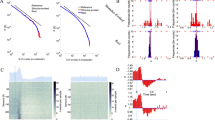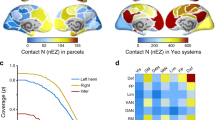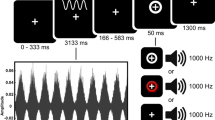Abstract
Numerous electroencephalography (EEG) and magnetoencephalography (MEG) studies aim at identifying the chronological order of activation of brain areas. This paper demonstrates that the timing sequence obtained with the gold standard for EEG/MEG analysis (averaging across trials) may not correlate at all with the actual transmission of a stimulus’ effect within a pathway formed by connected brain areas. This is shown by studying transmission of stimulus-locked responses in a model that shares basic features with stimulated neuronal rhythms: in two phase oscillators with bistable coupling and noise one oscillator is stimulated. The model presents a mechanism that causes a response clustering, i.e., a switching between two different responses across trials, without extinction of the averaged response (calculated over all trials). Transmission times are calculated for all trials as well as for the two clusters separately with standard averaged responses and with a stochastic phase resetting analysis. The stochastic phase resetting analysis provides reliable estimates of the transmission time. In contrast, transmission times calculated by averaging across trials correspond to the phase difference in the different stable synchronized states (when calculated for the two clusters separately) or their weighted superposition (when calculated over all trials). The standard method does not detect the time elapsing during the transmission of the stimulus’ action. The results presented here call into question many findings reported in the evoked response literature.
Similar content being viewed by others
References
Batschelet E (1981) Circular statistics in biology. Academic, London
Basar E (1980) EEG-brain dynamics: relation between EEG and brain evoked potentials. Elsevier, New York
Chiappa KH (1983) Evoked potentials in clinical medicine. Raven, New York
Coles MGH, Smid HGOM, Scheffers MK, Otten LJ (1995) Mental chronometry and the study of human information processing. In: Rugg MD, Coles MGH (eds) Electrophysiology of mind: event-related brain potentials and cognition. Oxford University Press, Oxford, UK, pp 86–131
Dawson GD (1950) A summation technique for the detection of small evoked potentials. Electroenceph Clin Neurophysiol 44:153–154
Effern A, Lehnertz K, Schreiber T, Grunwald T, David P, Elger CE (2000) Nonlinear denoising of transient signals with application to event-related potentials. Physica D 140:257–266
Gardiner CW (1985) Handbook for stochastic methods for physics, chemistry and the natural sciences, 2nd edn. Springer, Berlin Heidelberg New York
Greenwood PE, Ward LM, Russell DF, Neiman A, Moss F (2000) Stochastic resonance enhances the electrosensory information available to paddlefish for prey capture. Phys Rev Lett 84:4773–4776
Hämäläinen M, Hari R, Ilmoniemi RJ, Knuutila J, Lounasmaa OV (1993) Magnetoencephalography – theory, instrumentation, and applications to noninvasive studies of the working human brain. Rev Mod Phys 65:413–497
Haken H (1983) Advanced synergetics. Springer, Berlin Heidelberg New York
Hari R, Salmelin R (1997) Human cortical oscillations: a neuromagnetic view through the skull. Trends Neurosci 20:44–49
Kuiper NH (1960) Tests concerning random points on a circle. Konikl Nederl Akad Wet Proc Ser A 63:38–47
Makeig S, Westerfield M, Jung T-P, Enghoff S, Townsend J, Courchesne E, Sejnowski TJ (2002) Dynamic brain sources of visual evoked responses. Science 295:690–694
Mayr S, Niedeggen M, Buchner A, Pietrowsky R (2003) ERP correlates of auditory negative priming. Cognition 90:B11–B21
Merigan WH, Maunsell JHR (1993) How parallel are the primate visual pathways? Annu Rev Neurosci 16:369–402
Panter P (1965) Modulation, noise, and spectral analysis. McGraw-Hill, New York
Risken H (1989) The Fokker–Planck equation: methods of solution and applications, 2nd edn. Springer, Berlin Heidelberg New York
Sohmer H, Feinmesser M, Szabo G (1974) Source of electrocochleographic response as studied in patients with brain damage. Electroenecephalogr Clin Neurophysiol 37:663–669
Steriade H, Jones EG, Llinás R (1990) Thalamic oscillations and signaling. Wiley, New York
Tass PA (1999) Phase resetting in medicine and biology – stochastic modelling and data analysis. Springer, Berlin Heidelberg New York
Tass PA (2002) Stimulus-locked transient phase dynamics, synchronization and desynchronization of two oscillators. Europhys Lett 59:199–205
Tass PA (2003a) Stochastic phase resetting of stimulus-locked responses of two coupled oscillators: transient response clustering, synchronization, and desynchronization. Chaos 13:364–376
Tass PA (2003b) Stochastic phase resetting of two coupled phase oscillators stimulated at different times. Phys Rev E 67:051902
Tass PA (2004) Transmission of stimulus-locked responses in two coupled phase oscillators. Phys Rev E 69:051909
Winfree AT (1980) The geometry of biological time. Springer, Berlin Heidelberg New York
Author information
Authors and Affiliations
Corresponding author
Rights and permissions
About this article
Cite this article
Tass, P. Transmission of stimulus-locked responses in two oscillators with bistable coupling. Biol. Cybern. 91, 203–211 (2004). https://doi.org/10.1007/s00422-004-0512-4
Received:
Accepted:
Published:
Issue Date:
DOI: https://doi.org/10.1007/s00422-004-0512-4




